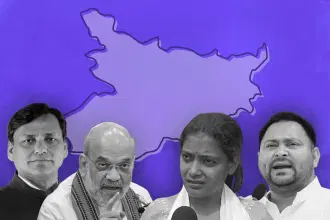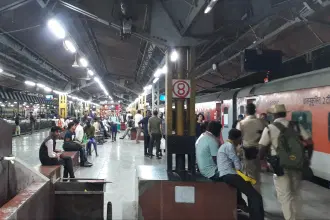Economy
Opportunity Amidst Uncertainty: 7 Takeaways From Conversation With Neelkanth Mishra On US Tariffs And India's Economic Reforms
Diksha Yadav
Aug 27, 2025, 05:21 PM | Updated Sep 01, 2025, 03:28 PM IST
Save & read from anywhere!
Bookmark stories for easy access on any device or the Swarajya app.


On Swarajya's What This Means podcast, Neelkanth Mishra, Chief Economist at Axis Bank, Head of Global Research at Axis Capital and member of the Prime Minister's Economic Advisory Council, provided a nuanced perspective on the Trump administration's tariff policies and their implications for India.
Here are the seven key takeaways from this conversation.
1. The 50 Per Cent Tariff Is A Negotiating Tactic, Not Economic Policy
Mishra was categorical in his assessment: the proposed 50 per cent tariff on Indian goods is "what they call in Hindi a गीदड़ भभकी (Gidar Bhabki)" – essentially an arm-twisting tactic rather than a serious economic policy. He emphasised that attempting to quantify the impact of such irrational tariffs gives them undue importance.
"By trying to quantify it, you are actually putting more pressure on yourself," Mishra explained. "Such analysis plays into the hands of negotiators who are seeking to maximise their leverage."
His base case scenario anticipates tariffs settling at around 25 per cent or even lower as negotiations progress, making the current 50 per cent figure more of a theatrical opening gambit than a sustainable policy position.
"I think it's extremely unlikely that these duties will stick. If they do, the impact could be quite substantial. It's very hard to quantify, but out of about $85–90 billion exports to the US, around $50 billion or so is subject to these reciprocal tariffs. The rest fall under different acts. If you impose a 50 per cent duty on those, it's quite possible that some of the trade simply won't happen. So, the impact could be very significant. But I don’t think that’s the right way to think about this, it's more of a negotiating tactic."
2. Limited Direct Impact On Average Indians
For the everyday Indian, Mishra believes the direct impact will be minimal. While for certain export hubs like Tirupur (textiles) and Surat (gemstones and jewellery), there can be some near-term impact. India's predominantly domestic demand structure provides a natural buffer.
"As a percentage of GDP, I think India is among the least affected. Most of our demand is domestic," he noted. The broader Indian economy, driven primarily by internal consumption and services, remains relatively insulated from these trade disruptions.
3. Echoes Of The Smoot-Hawley Tariffs
Drawing parallels to the infamous Smoot-Hawley Tariffs of the 1930s, Mishra provided historical context for the current situation. The weighted average tariff rate after recent announcements stands at about 18 per cent – the highest since the Smoot-Hawley era, which contributed to significant global trade disruption.
"Even the Smoot-Hawley tariffs weren't that far away from where we are now," he observed, suggesting that current policies could drive economic disruption.
"I'm reasonably sure that these tariffs will also cause quite a bit of damage. So it's just the first step. After three or four months of significant uncertainty, atleast some rates have started to get fixed, though those documents haven't been signed yet. I'm also hearing that some countries have been told that, say, 30 per cent of their goods will be presumed to be transshipped from China and therefore subject to an additional 40 per cent duty. So there are many such random things happening which will further complicate matters."
4. The Transshipment Game: A Cat And Mouse Dynamic
One of Mishra's most intriguing insights concerned the surge in transshipment activities. He provided compelling data showing how trade statistics between the US and China have become increasingly discordant since the first round of Trump tariffs in 2017.
Before 2017, US imports from China exceeded Chinese-reported exports to the US by $40-45 billion – a gap largely explained by freight and insurance costs. However, after the tariffs, this relationship inverted dramatically, with Chinese exports now exceeding US imports by $115 billion.
"In segments like apparel, if the number from China is 100, the Americans are saying we are importing only 55," Mishra explained. This discrepancy points to widespread transshipment through third countries and under-invoicing to avoid tariffs.
"So, many goods are being shipped to Canada, Belgium, Budapest, or other countries and then transshipped to the US. This trend is likely to become even more common, because the US customs department has relatively little experience with large-scale revenue collection from imports.
In contrast, the Indian customs department is accustomed to high import tariffs and generates significant revenue from them. For perspective, US customs revenue last year was only about $79 billion in a $30 trillion economy. Given these dynamics, a surge in transshipment seems likely."
The implications extend beyond trade flows. Mishra noted that the US's "errors and omissions" in balance of payments with China show a consistent positive $400 billion – suggesting a surge in what India would call "hawala" transactions to facilitate these trade circumventions.
5. GST Reforms: Long-Overdue Rationalisation, Not Tariff Response
Addressing recent GST announcements, Mishra clarified that these reforms represent necessary structural adjustments rather than responses to US trade pressure.
The GST rationalisation was necessary because the GST compensation cess was initially intended only to compensate states if they missed their promised revenue targets. Though the cess was extended, and theoretically it could have been extended further, but on what basis? Therefore, some form of GST reform became essential since the compensation cess had to be integrated into the GST structure.
The chosen solution — a simplified GST rate structure of 5 per cent, 18 per cent, and a special 40 per cent slab — is elegant and arguably overdue.
This rationalisation ideally should have been done in 2016 when GST was implemented. "I was an advisor to the Revenue Neutral Rate (RNR) Committee, and we suggested having one or at most two rates. However, at the time, the Finance Ministry officials were uncomfortable with the revenue neutrality calculations and opted for item-wise revenue neutrality instead."
This item-wise approach resulted in multiple slabs: for example, an excise duty of zero and VAT of 6 per cent landed at 5 per cent, a combination of 6 per cent and 9 per cent equalled 12 per cent, etc. Some states even had 4 per cent VAT, which explains why the 5 per cent slab existed.
"This is a reform rather than a consumption stimulus. It was inevitable to have this reform this year because it is the year when the GST compensation cess constitutionally ends, and therefore some form of GST adjustment was needed.
"I wouldn’t necessarily link it to the US tariffs, but at the same time, I think the uncertainty introduced by this tariff drama has at least strengthened the resolve to drive structural reforms. This is because the acceptance of structural reforms improves when there is a sense of uncertainty and stress — when the perspective is that unless we collectively solve the problems, the Indian economy will suffer. I think that sense may actually drive more reforms," he emphasised.
6. Strategic Reform Recommendations
Three key reform priorities for India, according to Mishra are:
Strengthen Internal Demand Through Housing: There is a significant opportunity to drive disruptive reforms in housing, which the government appears to share. The average Indian currently lives in about 130 square feet of constructed space, compared to roughly 550 square feet per person in a tier-3 Chinese town and 700 square feet per person in the US, and the size of that house is still growing at 1 per cent a year.
Given that demand for housing in India is largely internal, with labour and materials sourced locally, easing supply constraints — such as reducing compliance burdens, streamlining approval processes, and releasing locked-up land — could create substantial internal demand, driving job creation and improving housing quality.
Consolidate Government Holdings: The government should consider consolidating its public holdings into a single large holding company. This would enable more effective management of public assets and allow the shedding of stakes in sectors such as coal or related resources, where India now has private mines and these are no longer considered strategic assets, while investing more in strategic areas like lithium and rare earths.
Currently, the challenge is less about the size of the government’s balance sheet and more about the speed at which it can be mobilised. To address this, restructuring and streamlining government departments is necessary to respond quickly to strategic priorities amid global disruptions.
Accelerate Deregulation: Freeing up the corporate sector to compete globally remains crucial for long-term competitiveness.
7. The Jobs Challenge
The employment challenge in India is very tough and urgent. Unless we can employ everyone in the working-age group, we risk losing a large part of our demographic dividend. "I’ve been saying for years that we must “grow rich before we grow old.” Young people’s energy needs to be productively employed to create wealth for themselves and the country as they age, says Mishra.
The working-age population is growing by about 8 to 10 million annually, plus significant underemployment in agriculture (22-23 crore people calling themselves farmers while producing less than what 4 million Americans produce). Even if India needs 20 times more farmers to produce the same food as the US, that leaves around 150 million surplus agricultural workers. Over the next 15 years, shifting even a portion of them out of agriculture into other productive sectors means creating about a crore jobs per year.
Additionally, female labour force participation is very low — currently around 36-37 per cent, compared to 70 per cent in Vietnam and 68 per cent in China — suggesting another crore jobs may be needed annually if participation rates are to improve.
"Can you really create three crore jobs a year in a workforce which is 60 crore?" Mishra questioned. "I think that's a very, very hard challenge. So my fear is that we will lose a fair bit of our demographic dividend."
Despite this concern, he remains confident that solutions will emerge, and India can maintain a growth rate of around 7 per cent.
Conclusion: Opportunity Amidst Uncertainty
Mishra sees the current global uncertainty as potentially catalytic for India's reform agenda. Citing a foreign leader's observation that India's "tragedy is its large size and glorious history" because it never faces existential threats that drive disruptive reforms, he suggests that current pressures might finally create the political resolve needed for transformational changes.
The key lies in maintaining perspective – treating tariff threats as negotiating tactics rather than economic realities while using the uncertainty to drive meaningful structural reforms that strengthen India's long-term competitiveness and internal resilience.
P.S. Full episode coming up on What This Means soon.





